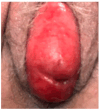Personalized Management of Hydroxyquinoline Hypersensitivity in Pessary Care: A Case-Based Approach to Tailored Treatment
- PMID: 40843887
- PMCID: PMC12372040
- DOI: 10.3390/reports8030145
Personalized Management of Hydroxyquinoline Hypersensitivity in Pessary Care: A Case-Based Approach to Tailored Treatment
Abstract
Background and Clinical Significance: Many women use pessaries to manage their symptoms of pelvic organ prolapse. Hydroxyquinoline is the active ingredient in gels and ointments that are often used to lubricate a pessary prior to vaginal insertion and to provide antimicrobial effects while the pessary is in situ. Case Presentation: A 74-year-old woman with multiple medication allergies develops vulvovaginal erythema and pruritus after increasing vaginal Trimo-San application frequency for pessary care and maintenance. These symptoms are deemed to be consistent with an allergic reaction to hydroxyquinoline, the active ingredient in Trimo-San. Conclusions: This report highlights the importance of personalized treatment in pessary management. It also demonstrates how personalized medicine can optimize outcomes and improve treatment adherence among individuals with complex medical histories.
Keywords: allergy; case report; dermatitis; hydroxyquinoline; pelvic organ prolapse; pessary.
Conflict of interest statement
The authors declare no conflicts of interest.
Figures
References
-
- Progetto Menopausa Italia Study Group Risk factors for genital prolapse in non-hysterectomized women around menopause. Results from a large cross-sectional study in menopausal clinics in Italy. Eur. J. Obstet. Gynecol. Reprod. Biol. 2000;93:135–140. doi: 10.1016/S0301-2115(00)00285-2. - DOI - PubMed
Publication types
LinkOut - more resources
Full Text Sources



